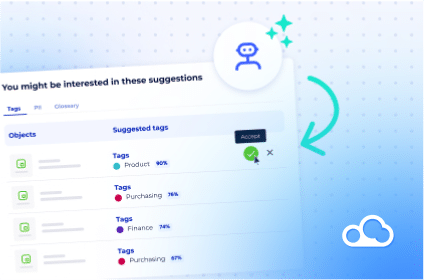The world of data is getting more complex making it harder for companies to quickly generate the insights they need to manage the business. According to a Boston Consulting Group survey, more than 50% of data is not used to generate insights and make decisions. At the same time, nearly three-quarters (73%) of respondents expect the number of nontechnical consumers of data will increase in the next three years.
Technology and data teams can no longer keep up with the demands for data. Semantic layers enable you to decode data complexity and empower people with a wide range of technical skills to easily find, understand, and use data. By embracing the power of semantic layers, you can accelerate time to insight and fuel business success in the ever-evolving data-driven landscape.
What is a semantic layer?
A semantic layer is an intermediary layer that sits between the underlying data sources and the end-user analytics tools or applications. It serves as a logical representation of the data, providing a simplified and unified view that is more easily understandable and usable for non-technical users. By mapping complex data into familiar business terms such as “product,” “customer,” or “revenue”, and defining metrics, hierarchies, and relationships between different data entities, the semantic layer enhances the accessibility, flexibility, and usability of data for analytics purposes.
Market trends driving the need for a semantic layer
The need for a semantic layer in modern data and analytics environments is driven by several market trends. These include increasing data complexity driven by an exponential growth in data volumes, as well as ever-expanding sources of data across on-premise and multi-cloud infrastructures. The need to empower self-service data access to more users, for more analytical use cases to accelerate decision-making in response to changing market conditions. And the need to comply with growing regulations around data privacy, residency, and sovereignty, as well as ensuring fairness and transparency in AI and machine learning algorithms.
How does a semantic layer address market trends?
A semantic layer simplifies data complexity by cataloging data from multiple sources and standardizing business entity definitions. By mapping different data definitions from different sources to the standard definition, users are presented with a unified view of the data, regardless of its original source. This consolidated and consistent view makes data easier to find and trust.
The semantic layer empowers self-service by mapping technical data elements like database columns names to business terms and metrics like “supplier”, “material”, and “on-time delivery rate.” Mapping data helps users explore and use data without having to understand technical names in different data sources. The semantic layer also provides pre-defined data models and reporting hierarchies to accelerate analysis.
Semantic layers help ensure compliant and ethical use of data by providing a centralized point for implementing data governance and privacy controls.
- Defining user roles, permissions, and data-level security, ensuring that users only access the data they are authorized to view.
- Creating policies that govern areas like data collection, consent for use, and localization of data storage and processing.
- Documenting the data used, the processing steps involved, and any associated bias mitigation strategies, to demonstrate transparency and accountability in AI models.
Benefits of a semantic layer
Semantic layers help decode data complexity by making data easier to find, understand, and use. The benefits of reducing complexity include faster decision-making, greater collaboration, and increased AI accuracy and fairness. Let’s take a closer look at how semantic layers deliver these benefits.
1. Semantic layers speed up decision-making by simplifying data access, providing a unified view of data, ensuring consistent data definitions, and providing visibility into the sources and lineage of data. These capabilities reduce the time required to gather and analyze relevant data, derive insights, and take action in response to changing market conditions.
2. Semantic layers improve collaboration by establishing common terminology, metrics, and models that ensure all stakeholders have a shared understanding of the meaning and context of data. This shared understanding fosters effective communication, reduces misunderstandings, and promotes collaboration among teams with different backgrounds and expertise.
3. Semantic layers improve AI accuracy and fairness by establishing standardized definitions, rules, and policies for data that ensure the input data used in machine learning models is accurate, unbiased, and consistent. They assist domain experts and data scientists in feature engineering, which involves selecting and curating the most informative data attributes for training models, resulting in improved accuracy. Additionally, semantic layers enable iterative model refinement and validation, contributing to more accurate predictions, classifications, and insights.
Conclusion
In the face of increasing data complexity, the need for self-service data access, and growing data privacy regulations, a semantic layer serves as a critical component in modern data and analytics environments. By simplifying data access, providing a unified view, and establishing consistent data definitions, semantic layers enhance decision-making processes, reduce time-to-insight, and promote collaboration among diverse teams.
With improved data accuracy and visibility of lineage semantic layers help improve AI model output and transparency. Don’t let your data go untapped! A semantic layer can help fuel business success in the ever-evolving data-driven landscape.
Discover DataGalaxy’s Data Knowledge Catalog: An all-in-one platform that features user-friendly software with natural language processing to easily provide access to all your business’ data knowledge. Learn more by booking a demo today!





